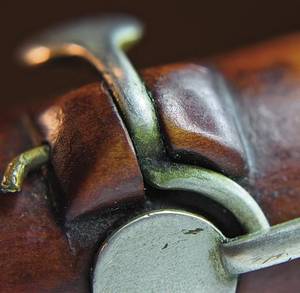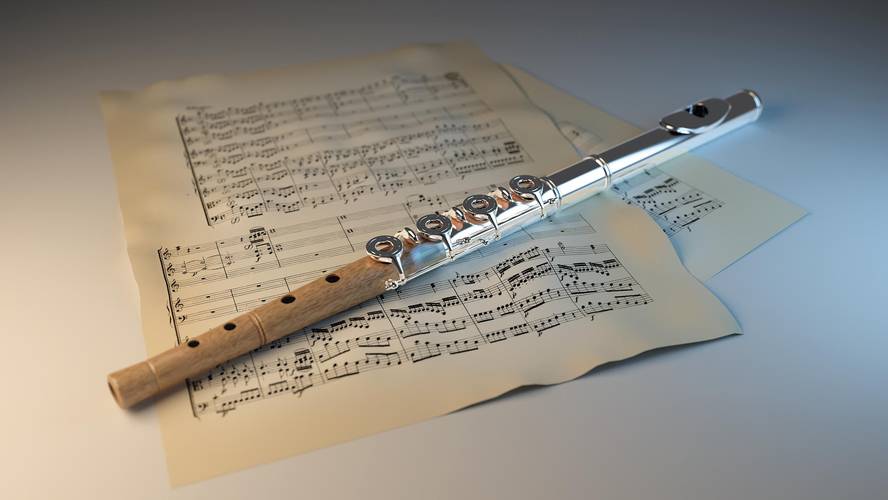Route of the wooden flute to metal
The flutes that Bach, Mozart and Beethoven knew were made of wood. But at the time of Beethoven's death, flutists were already testing new systems that were then very successful. The flutes changed completely. Among other things, they became metal. And so they continue.
Manufacturers have been manufacturing metal flutes for more than 160 years and will continue to do so. "It will be for long," says flutist Antonio Arias and expert in this instrument. The standard flute used in the orchestra is silver or gold. Wooden flutes are still manufactured, but only for very specific uses. "In the National Orchestra of Spain we have two modern wooden flutes that we use occasionally to interpret the classical repertoire and the music of the beginning of the romanticism. In these cases we are looking for a less brilliant sound to embed with oboes, clarinets and fagos, wooden instruments", explains Arias. But the wooden flutes are exceptions in the orchestra.
However, it is still classified in the group of wooden instruments. There are several reasons for this, especially tradition and type of sound. On the one hand, it has not traditionally existed in the group of metal instruments and, on the other, the timbre of the metal flute is closer to the oboe than to the trumpets. It is true that it changed the timbre of the wood to metal. "In Germany, Anton-Bernhard Fürstenau and other flautists said that the timid equality of the new flute prevented the original character," says Arias.
Revolutionary Böhm

The complaints were, of course, but the change was successful quickly. In short, it was a change provoked by the flutist revolutions themselves, especially by the German Theobald Böhm. In fact, today's standard flute is called Böhmen's flute. "He was a very versatile man. His greatest contribution was the design of an instrumental model that remained in force 150 years later, with a few details. His work in metallurgy and mechanics was awarded on several occasions. On the other hand, he was a renowned performer who offered numerous concerts in Europe", explains Arias. The flutist directly influenced her craft work. "If the manufacturer himself experiences, he can know first hand what he wants, the defects presented by the instrument and its positive characteristics. Böhm wrote the variations of a Schubert theme to use it somehow as a demo of the new system. He introduced violent changes of tonality by jumping from dieses to bemoles. This kind of music could hardly be played with the system before Böhmen".
One of the keys was the opening and closing mechanism of the holes. Key systems were already common, but Böhm developed a much more sophisticated system. It was ergonomic and at the same time allowed opening and closing holes away from the fingers. It was a complex work of engineering that allowed to use purely acoustic criteria to determine where the holes should be performed. It did not matter where the fingers were; the important thing was where the holes had to be so that the tuning was perfect. In addition, they were large holes, larger than the finger can cover. The hole of the mouth was also large, which gave sonority to the sound of the flute.
Taking advantage of the big holes was not the invention of Böhmen. All biographies show that Charles Nicholson was surprised by the sound he obtained thanks to the large holes. "Böhm had a great sense of invention and was very skilled because he learned the art of goldsmith with his father. In 1928 he met the famous Nicholson in London and was fascinated by his sound. Nicholson's flute holes had a diameter greater than usual. Böhm returned to Munich, opened a flute factory and with the experience acquired designed a new model", explains Arias. It was not the first flute made by Böhm, but it was the first to be called Böhmen flute; it was 1832."
Nicholson had big hands and fingers, and so he could cover the big holes; thanks to the keys of the flute of Böhmen, also could cover the big holes the flutists who did not have big fingers. But Nicholson's flute had another problem: it had a cone shaped body and a cone shaped inner tube. The shape of the inner tube is very important in the wind instruments, since the sound is produced by vibrating the column of air in this form. The cone did not work properly and Böhm resorted to a physical. "A friend, Carl von Shafthäutl, professor of acoustics, was asked for advice on the properties of cylindrical and conical tubes. The conclusion was that the cylinders fit more easily to the acoustic laws, which Bernouilli presented," explains Arias.
Arrival of the metal

"It was decided that the tube was metal because the metal tube walls are smoother. In fact, the stationary waves generated inside the tube are cushioned on the walls of the tube, and the softer the surface is its attenuation. It is not surprising that the flutes prior to the formation of metallic are made of very compact grain wood, rosewood, ebony or boj. Copies of ancient instruments with which the wood is made, as well as current oboes and clarinets, are still made," says Arias.
Metal has other important advantages compared to wood. On the one hand, the manufacturer can make corrections as the new type of instrument or design is being tested. Metal allows experiments; with wood the corrections are almost impossible. On the other hand, Arias points out that the metal flute has fewer problems when attaching the key mechanisms to the body of the instrument: "The mechanism of keys is adapted to the wood by screws, which can cause fissures in the body. On the contrary, a mechanism welded to metal is safer."
Böhm knew how to work the metal. And, in addition, it was born in a very adequate time, the XIX. The new techniques of extraction of mineral iron were developed at the beginning of the twentieth century. Therefore, the raw material was more affordable, better and the flutist Böhm had a great skill and curiosity. All the features joined together to initiate a revolution in the design of the flute, which occurred.
Wooden wooden instruments of wood

The flute changed forever, but not the rest of the instruments of the wood group. The oboe, the clarinet, the fagot and the instruments of the family of the three continue in wood. And in spite of the advantages of the metal against the wood, they have not suffered the same change that has suffered the flute.
But these wooden instruments have another feature. They are not hit as the flute plays, but use other strategies to make the air vibrate. The clarinet nozzle uses a flexible sheet to make the air vibrate, a tongue. When the musician blows, the tongue hits the mouth of the clarinet causing the vibration. The oboe and the fagot have a nozzle formed by two reeds; the musician must make the reeds vibrate between them. And in both systems, both of a single reed and of two reeds, the sound of the instrument is very high than the one that produces the flute.
The sound of the flute needed more strength, especially as new musical forms were created. When the concept of concert was modernized, the soloist had to play above the sound of the orchestra, and for it the sound of the flute had to be sound. For the same reason, the design was adapted to violins and string instruments, XVII. In the twentieth century, especially in the workshops of the city of Cremona, like the famous Stradivaris. In the case of flute, this technological change occurred 150 years later. Arias sees the change from a broad perspective: "I think the problem is complex and several factors are involved. One cannot deny the cultured music XVIII. It begins to democratize in the mid-twentieth century. This was pioneered by Johann Christian Bach and his friend Karl Friedrich Abel. This meant the need for more sonorous instruments. We are still immersed in this process, because today we play in larger rooms and in which there is a lot of audience."
Böhm was a very good publicist. His compositions sounded throughout Europe with the new flute. "The answers were very varied and a paradox is that in France it had better reception than in Germany. In 1837, Paul-Hippolyte Camus introduced a new flute in France and was accompanied by Vincent-Joseph Dorus of the Paris conservatory and his assistant Victor Coche. Later, other countries approved the new system, such as England and the United States." And little by little it was assumed by Germany. The flute changed. And with flute, flutters.






